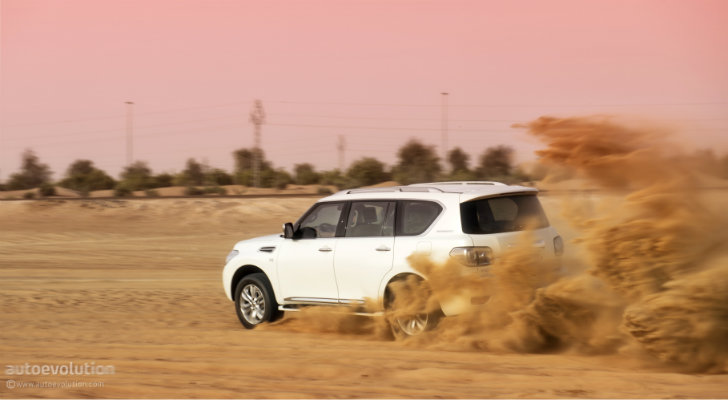Just like the twin-turbo versus biturbo engine delusion, another commonly mistaken belief in the wondrous world of automobiles is the four-wheel drive versus all-wheel drive topic. There are a few notable differences between the two, but many people and gearheads are throwing these two terms unknowingly. So what are the main differences between 4WD and AWD and do they really matter?
Well, yes. As a general rule, four-wheel drive (4x4 or 4WD) is employed by large SUV vehicles such as the Nissan Patrol pictured above. Of course, in this day and age you'll find as many versions of 4WD as there are stars in the sky, but the basics are easy to understand. Compared to all-wheel drive, 4WD systems can be disengaged if you need to improve fuel economy. Mechanically speaking, 4WD drivetrains employ two diffs and a transfer case, while AWD uses three differentials (at the center, front and rear).
A four by four vehicle's transmission is transferring the engine's power to a contraption we usually refer as the transfer case. This device splits power evenly between the front and rear axles of the car, providing each wheel with the maximum amount of torque. That sounds fine and works well in off-road situations, but there is one big drawback. You don't need maximum torque in most driving conditions such as when cruising at 35 mph on a straight, dry road. Extra friction equals wasteful fuel consumption.
Thankfully, four by four systems get around this issue by sending traction only to two wheels in ordinary driving situations, that is only if you operate a lever, push a button or the electronic brain that governs modern four-wheel drive systems senses you don't need maximum attack.
Now for the all-wheel drive end of the story. As it happens, AWD is more modern than the old 4WD, but that doesn't mean it's better. Better is defined by what you need to do with your car. For starters, the most notable difference between all-wheel drive and 4WD is that it works all the time. You can't disengage it and use 2WD to improve fuel economy like you can on a four-wheel drive vehicle. Moreover, this setup isn't as good in extreme off-road conditions. But the pros come in the form of superior grip and car control in most driving conditions, along with better handling and traction under hard cornering.
AWD comes in two guises: mechanical or electronic. Compared to 4WD, all-wheel drive is constantly shifting power between the front and rear depending on road conditions, but can also shift power individually between two wheels be it at the front or rear. The latter is also known as torque vectoring.
All-wheel drive is especially handy in slippery conditions such as when it's raining and it's no wonder why cars such as the Subaru Impreza WRX STI, Mitsubishi Lancer EVO X, Mercedes-Benz E63 AMG S, Audi R8 and Lamborghini Gallardo employ this system. Let's not forget that the daddy of all-wheel drive, the legendary Audi Quattro, has dominated the world rally scene for nearly a decade thanks to this setup.
A four by four vehicle's transmission is transferring the engine's power to a contraption we usually refer as the transfer case. This device splits power evenly between the front and rear axles of the car, providing each wheel with the maximum amount of torque. That sounds fine and works well in off-road situations, but there is one big drawback. You don't need maximum torque in most driving conditions such as when cruising at 35 mph on a straight, dry road. Extra friction equals wasteful fuel consumption.
Thankfully, four by four systems get around this issue by sending traction only to two wheels in ordinary driving situations, that is only if you operate a lever, push a button or the electronic brain that governs modern four-wheel drive systems senses you don't need maximum attack.
Now for the all-wheel drive end of the story. As it happens, AWD is more modern than the old 4WD, but that doesn't mean it's better. Better is defined by what you need to do with your car. For starters, the most notable difference between all-wheel drive and 4WD is that it works all the time. You can't disengage it and use 2WD to improve fuel economy like you can on a four-wheel drive vehicle. Moreover, this setup isn't as good in extreme off-road conditions. But the pros come in the form of superior grip and car control in most driving conditions, along with better handling and traction under hard cornering.
AWD comes in two guises: mechanical or electronic. Compared to 4WD, all-wheel drive is constantly shifting power between the front and rear depending on road conditions, but can also shift power individually between two wheels be it at the front or rear. The latter is also known as torque vectoring.
All-wheel drive is especially handy in slippery conditions such as when it's raining and it's no wonder why cars such as the Subaru Impreza WRX STI, Mitsubishi Lancer EVO X, Mercedes-Benz E63 AMG S, Audi R8 and Lamborghini Gallardo employ this system. Let's not forget that the daddy of all-wheel drive, the legendary Audi Quattro, has dominated the world rally scene for nearly a decade thanks to this setup.

